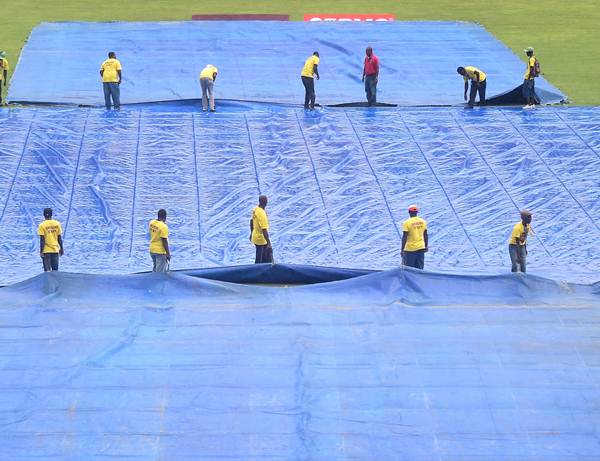Unicover method to minimise loss of play in rain-affected cricket matches
2 Min Read


Rains are fabulous’ ask any random person, they won’t disagree. They will certainly say: They are refreshing. They lighten up the mood. Watching tiny droplets of water gently falling on grass is very soothing and instantly make you feel good. There are very few things in the world that can match the joy of calmly watching it rain.
But, ask any die-hard cricket fan, sitting in any part of the world, if he feels the same. He will give you a big no! The words written above will never come out the mouths of the cricket fans, especially when there is a game going one. It’s quite well-known that the unexpected showers are the biggest villains in the game of cricket. Despite all the technical advancements we have witnessed in the game, the authorities sometimes look completely helpless when water covers the ground forcing the game to halt abruptly.
In the India-New Zealand Test in Kanpur, India’s 500th Test match, which India won by 197 runs, the visitors were 152 for one at tea on the second day when it started raining. But though the rain relented and despite bright sunshine, the rest of the day’s play was lost as the ground staff feared that removing covers immediately could endanger the ground. Moving the water logged covers would result in seepage and more damage to ground conditions.
The drill when it starts raining is cricket grounds are covered with multiple covers manually. It takes time to cover and they cannot cover the entire ground in time. Even after covering, rainwater seeps through the edges and the ground gets damp in a case of heavy rain. Even with super soppers at work, it takes time to dry the covers and matches get delayed or sometimes cancelled after a long wait due to wet outfield.
A solution to playground management has been found Yaamalaiah, a training and placement officer at Krishna Chaitanya Institute of Technology and Sciences in Markapur of Andhra Pradesh. Yaamalaiah reckons the outfield would not get wet if the entire ground is covered with a single cover in quick time. Rainwater that falls on the cover, he said, will reach the boundary along the ground and flows out through the gutter/moat along the playing field. If his solution works fine, there will be no need for super soppers.
His invention, Yaamalaiah said, does exactly that. The Unicover method solves the problem by covering the entire ground with a single waterproof cover. That can be done by an apparatus which holds, unrolls and rolls back the rain cover. Instead of allowing water and mopping, this apparatus prevents rain water from falling on the outfield surface and the cover does not allow water seeping onto the ground as the said cover has no gaps. Water that falls on the cover reaches the edge/boundary of the ground and exits through the ditch/gutter/moat.
Also read – Brad Hogg wants to bowl at Sachin Tendulkar again
Yaamalaiah said the apparatus is installed on one side of the ground near the boundary. It comprises two vertical bars, one rotatable horizontal bar, and one rain cover. The waterproof cover, equivalent in size and shape of the playground, is wound to the horizontal bar that can be rotated with the help of an electric motor.
When it starts raining, the apparatus’ cover holding the bar is rotated so that the waterproof cover rolls onto the ground. Groundsmen spread the cover and rainwater that collects on the cover rolls into the moat – as most playgrounds have surfaces that slope towards the boundary – so the ground staff can immediately roll back the covers, he said. The idea is to cover the ground up to the boundary, up to the reach of the ditch, without allowing rain water to fall on the surface so that play can resume immediately after rain.
The closest invention to his apparatus, or ‘prior art’ Yaamalaiah said, is the Brumbella. It carries rain cover onto the ground and spreads on the surface but is heavy and could damage the pitch. It’s also slow and cannot cover the entire ground. Other solutions include roof like structures by placing apparatus above the ground, but these methods are compatible with playgrounds with highrises around them.
Most playgrounds are sand based outfields with underground drainage. So the pores close when super sopper runs and wetness accumulates over a larger area instead of drying, making it difficult to mop. “Dr. DY Patil Sports Stadium in Mumbai and ACA-VDCA Stadium in Visakhapatnam have a sand base, while Eden Gardens in Kolkata is clay-silt based,” Yaamalaiah said.
Also read – Ravichandran Ashwin reveals his intention to watch Babar Azam live
It was sheer imagination that led to this discovery. “I follow cricket closely and was wondering if I could come up with an invention that could minimize loss of play. I’m grateful for all the technical support from the college, especially the Mechanical Engineering department in finding an alternative like this. My position envisages new opportunities for students with new developments in technology and I hope this will be one, but ‘patent infringement’ is very common and I have to be on guard,” said the Science undergraduate, who also has a Masters degree in English Literature.
Download Our App